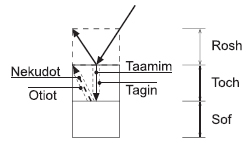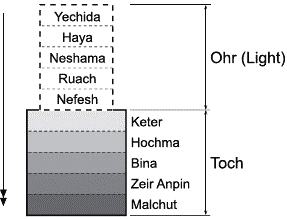Chapter 3.7 - Expansion And Withdrawal of Light
Once Malchut (who is considered a female Partzuf) decides to receive some of the direct light into her Toch, she stops receiving. Malchut always calculates in the Rosh (head) what is the maximum amount of Light she can receive in order to bestow. She always receives only a small part of the Direct Light, as receiving in order to benefit the Creator is against her nature.
As previously mentioned, the part of Direct Light that remains outside the vessel is called "Surrounding Light." It continues to pressure the vessel, which limits its expansion in the Partzuf and wants to break through the screen and fill up the entire vessel, including the Sof (end) of the Partzuf, just as it was prior to the restriction.
The Partzuf understands that if it only receives a part of the Light, meaning if it only fills itself as far as the Tabur (navel) and remains in that situation, the Thought of Creation would not be carried out. In order for it to be carried out the entire light must fill Malchut as it did prior to the restriction, except with the aim to bestow. But if the Partzuf receives more Light, meaning it receives below the Tabur, that would be reception in order to receive, because it doesn’t have a screen with which to activate these vessels in order to bestow.
Thus, the Partzuf decides to not receive altogether and return to the situation from before the reception. That decision is taken in the Rosh of the Partzuf, as do all decisions. Once the decision has been made, the screen that dropped from the Peh (mouth) to Tabur begins to rise back up to the Peh. The ascent of the screen makes the Lights exit the Partzuf through the Peh to the Rosh.
The decision to stop receiving the Light was made because there is a pressure on the screen that stands at the Tabur by the Surrounding Light. This lets it into the Partzuf to become Inner Light as well, while the Inner Light also keeps pushing down. These two Lights want to cancel the screen, which serves as a border that doesn’t let the Lights through. The pressure the Lights activate on the screen is called Bitush (Beating) of Inner Light and Surrounding Light.
These two Lights press on the screen that stands at the Tabur and limits the reception of Light into the Partzuf. They want the screen to drop from the Tabur so that the entire all the Surrounding Light can enter the Partzuf.
That situation is much like a person who receives some of the food given to him by the host and feels great pleasure at the reception. However, this weakens him, because he feels what great pleasures there are in the delicacies that he did not receive.
As a result, the screen returns from the Tabur to the Peh and the Partzuf empties itself of any Light. Just as the Light entered the Partzuf through the Peh, so it now leaves. The expansion of the Light from Above downward, from the Peh to the Tabur is called Taamim (flavors).
The withdrawal of the Light from the Partzuf is called Nekudot (points). Once the Light withdraws from the Partzuf, all that’s left is a reminiscence (Reshimo) of the Light, called Tagin. The Reshimo from the Light of Nekudot is called Otiot (letters).
The expansion of the Light and its withdrawal makes the vessel fit for its task, because only after the vessel feels the pleasure, which is then withdrawn, does it create a real desire for that pleasure. Once the Light is gone, there remains a Reshimo in the vessel. It is a Reshimo of the past pleasure, meaning the Nekudot. When the vessel is emptied of the Light, the Reshimo determines the desire and the yearning in the vessel. The Reshimo from the withdrawal of the Light is called Otiot, or vessel.
Prior to the restriction, the fourth phase received Lights from all four phases. The Light came to her from His essence through the root, first, second, third and fourth phases. That is why there are five phases in the fourth phase itself. Each phase of the five phases in Behina Dalet (the fourth phase) gets its Light from the corresponding phase:
-
Behinat Shoresh (the root phase) in Behina Dalet gets Light of Yechida (the Highest Light) from Behinat Shoresh.
-
Behina Aleph (first phases) in Behina Dalet gets Light of Haya from Behina Aleph.
-
Behina Bet (second phases) in Behina Dalet gets Light of Neshama from Behina Bet.
-
Behina Gimel (third phases) in Behina Dalet gets Light of Ruach from Behina Gimel.
-
Behina Dalet (fourth phase) in Behina Dalet gets Light of Nefesh from Behina Dalet.
Only Behina Dalet in Behina Dalet feels that her will to receive pleasure is really hers. Therefore, only this Behina is regarded as a creature. The other preceding phases in Behina Dalet are desires that Behina Dalet gets from Behinot Shoresh, Aleph, Bet, and Gimel. The desires in her preceding phases, though they are desires to receive, stem from the Creator, not from Behina Dalet herself.
Behina Dalet consists of five Behinot (phases). That structure is unchanging. These Behinot can be divided, filled, or joined in order to receive Light, but their structure nonetheless remains the same. It is named "the tip of the Yod (·), Yod (י), Hey (ה), Vav (ו), Hey (ה)."
The worlds and everything in them, except people, stem from the phases that precede Behina Dalet of Behina Dalet, and do not possess their own independent will. They are activated by the desires imprinted in them by the Creator, and are therefore not defined as creatures. Only human souls stem from Behina Dalet in Dalet, where the will to receive is really hers. Hence, only human souls are regarded as creatures.
The real desire to receive for herself is created only in Behina Dalet of Dalet. She is the only one that feels as a receiver; therefore she is also the only one that decides to restrict the reception of the Light. But the Light leaves the other Behinot in Behina Dalet as well; because only the Dalet of Dalet actually receives, and the preceding Behinot only develop her will to receive. When she stops receiving, the Light withdraws from all of them, because all five Behinot (plural for Behina) are in fact one vessel, the tip of the Yod (·), Yod (י), Hey (ה), Vav (ו), Hey (ה).
After the restriction, when Malchut receives the five Lights through the screen, they still go inside the same five parts of Malchut. The order of the entrance of the Lights into the Partzuf runs from the smallest to the greatest – Nefesh, Ruach, Neshama, Haya, Yechida –hence the name NRNHY (pronounced as NaRaNHaY).



